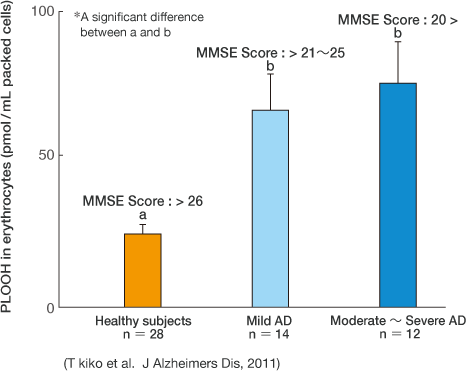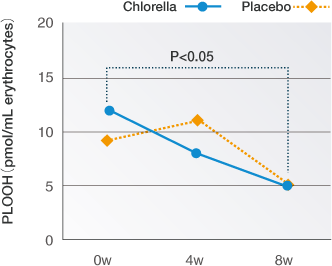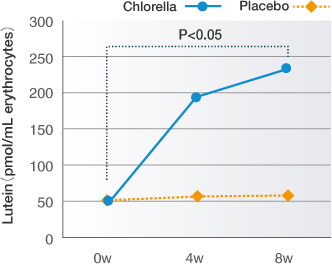Chlorella research report
- HOME
- Research report
- Chlorella research report

The chairman of "Society for Chlorella and Functional Plants Research"
Professor at New Industry Creation Hatchery Center, Tohoku University
Teruo Miyazawa, Ph.D.

The possibility of preventing the progress
of senile dementia
(Published in the Journal of Oleo Science 2013)
It helps transferring oxygen to brain cells
In patients with senile dementia, including those with Alzheimer's disease(AD), an abnormal accumulation of phospholipid hydroperoxides (PLOOH) is observed in the erythrocyte membrane. This condition shows the aging of erythrocytes and it is suspected that aged erythrocytes are associated with decreased oxygen transfer to brain cells, which may contribute to the progress of senile dementia.
It is proven that chlorella can decrease the accumulation of PLOOH.
Patients with senile dementia have a lot of aged erythrocytes.
It is reported that PLOOH in erythrocytes of AD patients is higher than in healthy subjects.
"Mini-Mental State Examination, MMSE" is used to check the decline in cognitive function. The maximum score for the MMSE is 30. If the score is below 27, the result is usually considered to be MCI. If the score is below 23, the result is usually considered to be dementia.
MMSE score decreases with the advanced AD grade, on the other hands, PLOOH increases with an advanced AD grade.

Lutein works mainly.
Chlorella is rich in lutein, which provides an anti-oxidant action to oxidation of PLOOH in erythrocytes, and it works fine in our bodies.
Lutein which is essential for erythrocytes and PLOOH which increase with advancing age.
It helps increasing essential components for erythrocytes
The concentration of Lutein in erythrocytes

It helps decreasing PLOOH which increase with advancing age.
The concentration of PLOOH in erythrocytes

【Method of experiments】
A randomized, double-blind, placebo-controlled study was conducted with 12 healthy middle-aged and elderly men and women (age: 50–68 years). The subjects were divided into a Chlorella group and a placebo group (6 subjects for each group). The subjects ingested 8 g (40 tablets daily; 20 tablets in both the morning and in the evening) of either Chlorella or placebo for 8 weeks. To evaluate the effect of Chlorella, the concentrations of lutein and PLOOH in erythrocytes were measured before ingestion, at 4 weeks after the start of ingestion, and at 8 weeks after the start of ingestion.
【Results】
In the Chlorella group, the concentration of lutein in erythrocytes increased by approximately 4.6 times, from 49.7 pmol/mL before ingestion (0 wk) to 230.7 pmol/mL at 8 weeks after the start of ingestion (8 wk). The concentration of PLOOH in erythrocytes of subjects in the Chlorella group showed a significant decrease from 11.9 pmol/mL at 0 wk to 5.0 pmol/mL at 8 wk (P < 0.05). In the placebo group, no significant change was observed in the concentrations of lutein and PLOOH in erythrocytes. There were no adverse events due to Chlorella ingestion.


